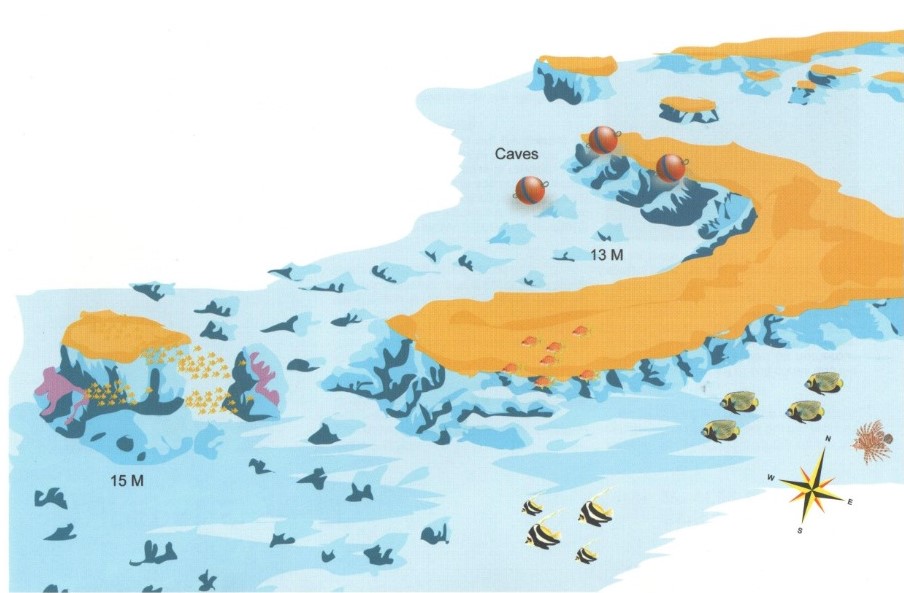
LOCATION:Hurghada
DESCRIPTION: Wall dive
DEPTH: 10-12 metres
VISIBILITY:20 – 25 metres (65 – 80 feet)
For the lovers of photogenic sites near Hurghada, with feather tailed rays and turtles regularly swimming by. Spot the anemone fish in their hundreds.
In the vicinity of Big Giftun, and close to Ben el Gebel, this sheltered crescent-shaped reef is suitable for most levels of divers. It’s around 90 minutes of sailing to reach Banana Reef.
Here, moorings are located on the south side of the main reef. The crescent formation is enclosed by an attractive coral garden and a pair of truly magnificent ergs. Banana of course refers to the reef’s unusual shape.
Current can be considerably strong in this area, effecting the visibility, also in shallow water. Actually, a drift is the most natural way to dive this spot. Although the wall of the reef isn’t particularly the most impressive part of Banana Reef, it serves as a good navigation point by keeping it in visual focus.
Banana Reef’s key features to fully appreciate diving are an amazing erg, boulders, gorgonias, bannerfish and sloping gardens of corals, decorated in lilac and purple colours.
The coral gardens slope down in northwest direction and gradually transform into a sandy patch at around 20 meters. On the southeast corner, and in the wall’s proximity is an enchanting anemone city. From here you are as if front row looking at two beautiful pinnacles, truly smothered with soft corals. They are reaching for the surface from depths of around 14 meters to 17 meters.
Simualr to nearby Ben el Gebel feather tailed rays and eagle rays regularly hover over the gardens of coral. Also, on this dive site you might have an encounter with a turtle or even a whitetip shark. Banana Reef is famous for its extensive colonies of banner fish, guarding a fan shaped boulder. The local pinnacle and gorgonian formations shelter lots of smaller fish.
You will just adore anamone city where hundreds and hundreds of anemone fish guard their juveniles. Where the pinnacles are decorated with gorgonias and soft coral, barracuda, jackfish, lionfish and groupers hunt schools of silversides and glassfish. These scenes turn Banana Reef in one of the best photogenetic sites in the Red Sea area near Hurghada.
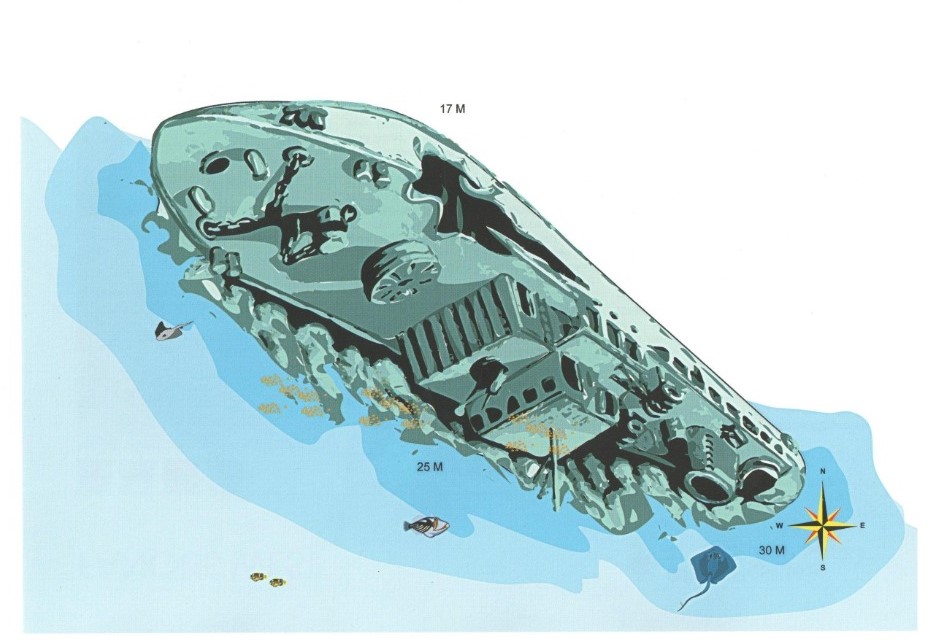
LOCATION: 27°13’55″N; 33°51’34″E
DESCRIPTION: Egyptian minesweeper
DEPTH: 26 metres (85 feet) to top of wreck, seabed at 30 metres (100 feet)
LENGTH: 70 metres (230 feet)
VISIBILITY: 30 metres (100 feet)
RATING: ****
The El Mina was bombed by the Israelis in 1969 in Hurghada bay, but still has a sister ship afloat nearby which is worth looking at to compare to what you are about to dive. The wreck now lies on its side and there are a lot of small holes to peer into and penetration is possible, although tight, through a significant amount of the wreck. Sea urchins are abundant on the wreck and a very large moray was found living in one of the holes. An interesting dive.

LOCATION: Hurghada
DESCRIPTION: Wall dive
DEPTH: 15- 50 metres
VISIBILITY: 20 – 25 metres (65 – 80 feet)
Hamda is known as ‘cleaning station’. The little cleaner wrasse clean the larger animals. There are even whale sharks in search of a cleanup. Hamda is situated on the northeast side of Big Giftun. It consists of a small plateau with a height ranging from 15 to 35meters. The plateau has a drop-off on either side which goes down more than 50 meters. Most of the marine life is past 15 meters.
Also look in the big blue ocean, there might be triggerfish, tuna, barracuda, sharks and turtles.

LOCATION: Hurghada
DESCRIPTION: Erg an Wall dive
DEPTH: 15 – 35 metres
VISIBILITY: 20 – 25 metres (65 – 80 feet)
There’s a vertical wall that spans out into a shelf with an erg, reaching up to 5 meters below the surface. The same shelf ‘ transforms’ into another wall, equipped with coral sculptures, one conjuring up visions of a pyramid.
Erg Somaya is slightly exposed to weather elements. For the deeper sections some experience is recommended. Currents can be strong and you will need good control of your buoyancy.
You can dive here from from the moorings or go for a drift. Both options offer the same feel of quality. At the northern part of the shelf you will notice the steep wall is intersected by a series of towering corals reaching out. They are carpeted with gorgonia’s and deeply colored soft corals. These towers are famed for their photogenic appearance.
Around the erg here there’s is sloping bottom of sand. It features a chimney at the northeast corner. You may enter on 30 meters on exit on 22 meters.
The erg itself starts at 5 meters and landing between 9 meters and a5 meters, containing rich marine life. It makes for a perfect safety stop.
One cannot emerge without having visited the cave, carpeted with gorgonians and soft corals. Erg Somaya’s summit is the chimney on the shelf, overflowing with glassfish.
Common features of the swimming kind are barracuda, snapper, jackfish and tuna. Wait until the afternoon for a chance meeting with Spanish dancers.
The coral towers break off shows huge swarms of silversides and anthias. Specifically worth mentiong are butterflyfish who come here in every possible species.
The chimney of the shelf is stunningly attractive, overflowered with a billowing curtain of glassfish. The erg is covered with invertebrates. Erg Somaya is classified as one of the most fascinating reef systems you’re ever likely to see.
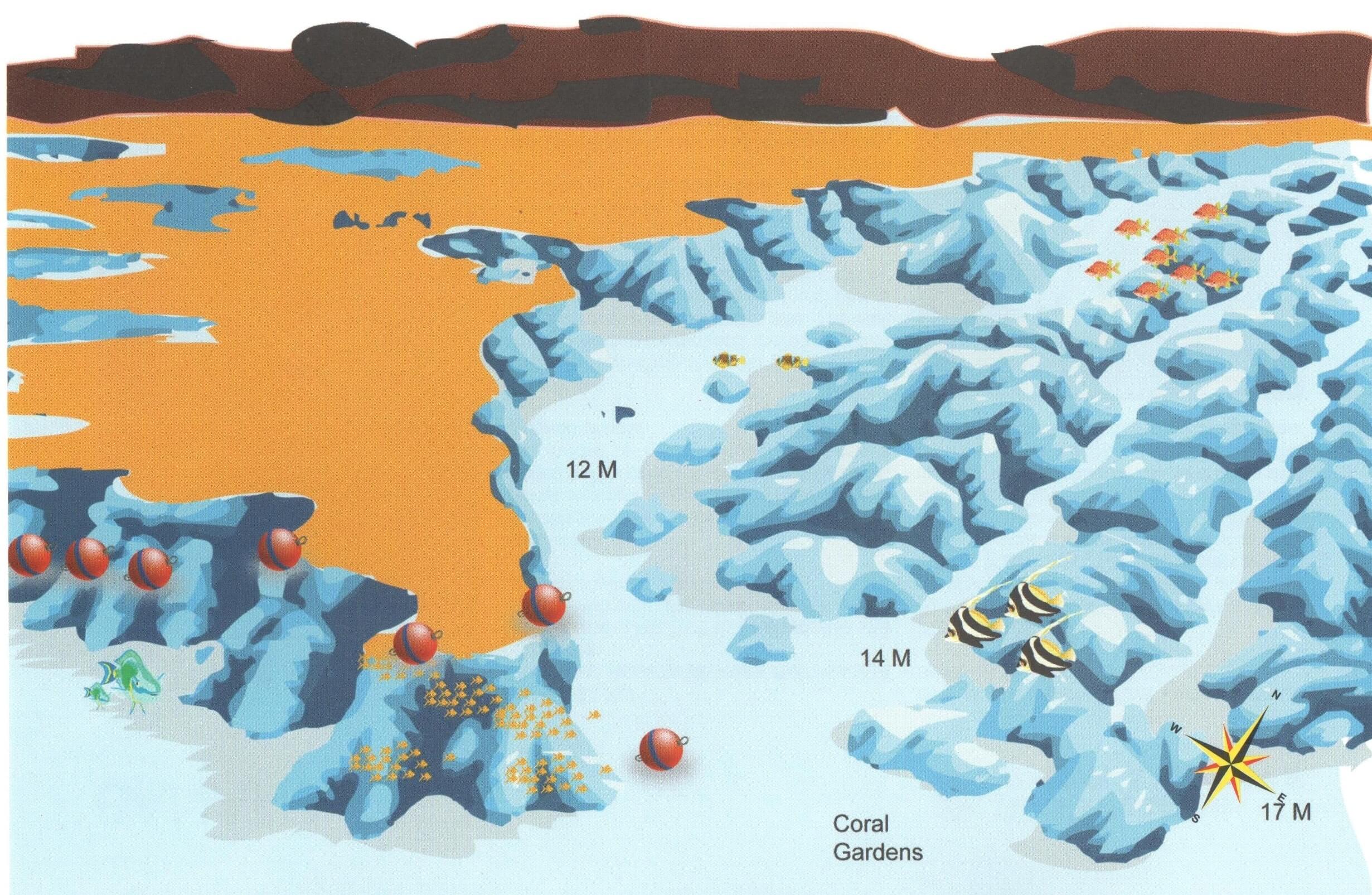
LOCATION: Hurghada
DESCRIPTION: Wall dive
DEPTH: 10-15 metres
VISIBILITY: 20 – 25 metres (65 – 80 feet)
The reef here pokes out from the eastern side of Giftun Kebira island and has a coral garden extending 300-400m north of it. The best way to dive this site is on the drift, dropping 300m out and using the gentle current to make your way back to the boat mooring. This area is known for its beautiful coral landscape rather than its fish life.
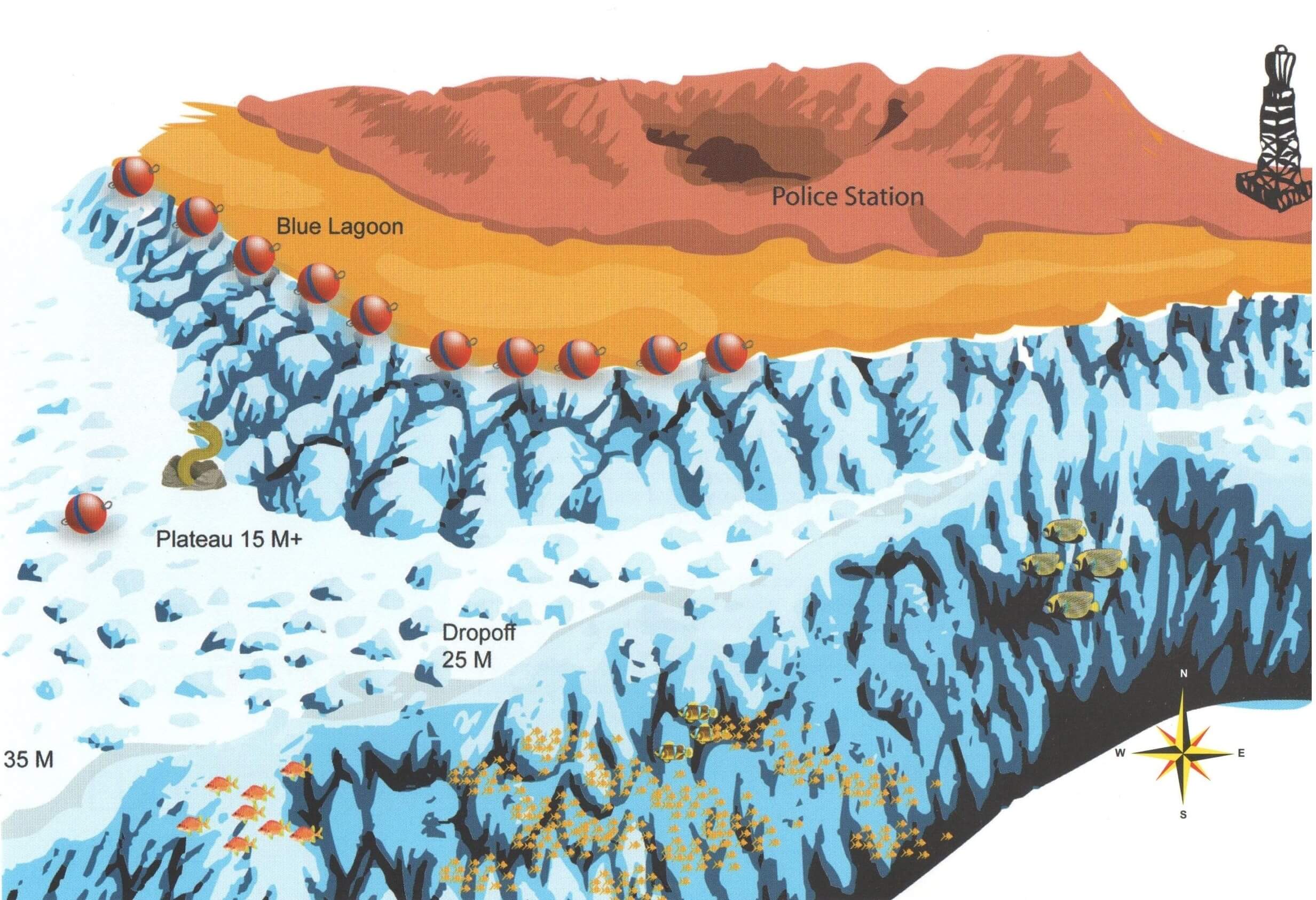
LOCATION: Hurghada
DESCRIPTION: Wall dive / drift
DEPTH: 100 metres (300 feet)
VISIBILITY: 20 – 30 metres (65 – 100 feet)
Giftun Island Your excellent dive choice of the day for hard and soft coral, napoleon wrasse and parrotfish, and, with a bith of luck, the odd buffalohead parrotfish.
Around 45 minutes separate Hurghada from the Giftun Islands. Giftun comes in two sizes, Kebier as in Big, and Sughayer or Saghir as in Small.
The Giftun beaches are in mint condition. Therefore they are a very popular excursion from Hurghada, offering snorkeling, diving and lazy sunbathing.
Close to the shore, the coral reef snorkeling is simply superb.
Offshore, the reefs boasts dramatic drop-offs for experienced divers.
Giftun is sometimes exposed to weather and strong current. Needless to say some experience is highly recommmended for the deep wall dive here.
Moorings are in place at the south side of Giftun Police station which is on top of a 15 meter to 25 meter deep plateau. This plateau transforms into a stretching shelf, allowing for the existence of the mentioned deep wall.
Although the plateau can be reached from the mooring system a drift is the preferable and natural choice. You drop next to a verticall wall and follow the current due south.
The eastern wall drops sheer to great depths. It is very contoured, and its craggy profile features some interesting caves. Some of these lie deep.
Where the main reef slightly curves to the west over the plateau, the drop-off takes on a zigzag appearance. At around 15 meters deeper there a spectacular tunnel. Please be alerted it is out of reach for recreational divers.
All over the drop-off huge gorgonians are waving in the current as if welcoming you to an underwater jungle. The plateau itself at Giftun is a half-covered coral garden. Eventually it leads up to the wall’s shallower parts.
As said, the swaying huge gorgonians create the illusion of an underwater jungle, serving as a drawn transparant curtain for longnose hawkfish, luring on their prey. Occasionally turtles hover over the coral forest, as well as napoleon wrasse. Giftun is also the sight of moray eels cruising the wall. The site is patrolled by pelagic species like barracuda and tuna.
The waters of the Red Sea here are teaming with aquatic life, colourful fish and beautiful corals, all ready for you explore.
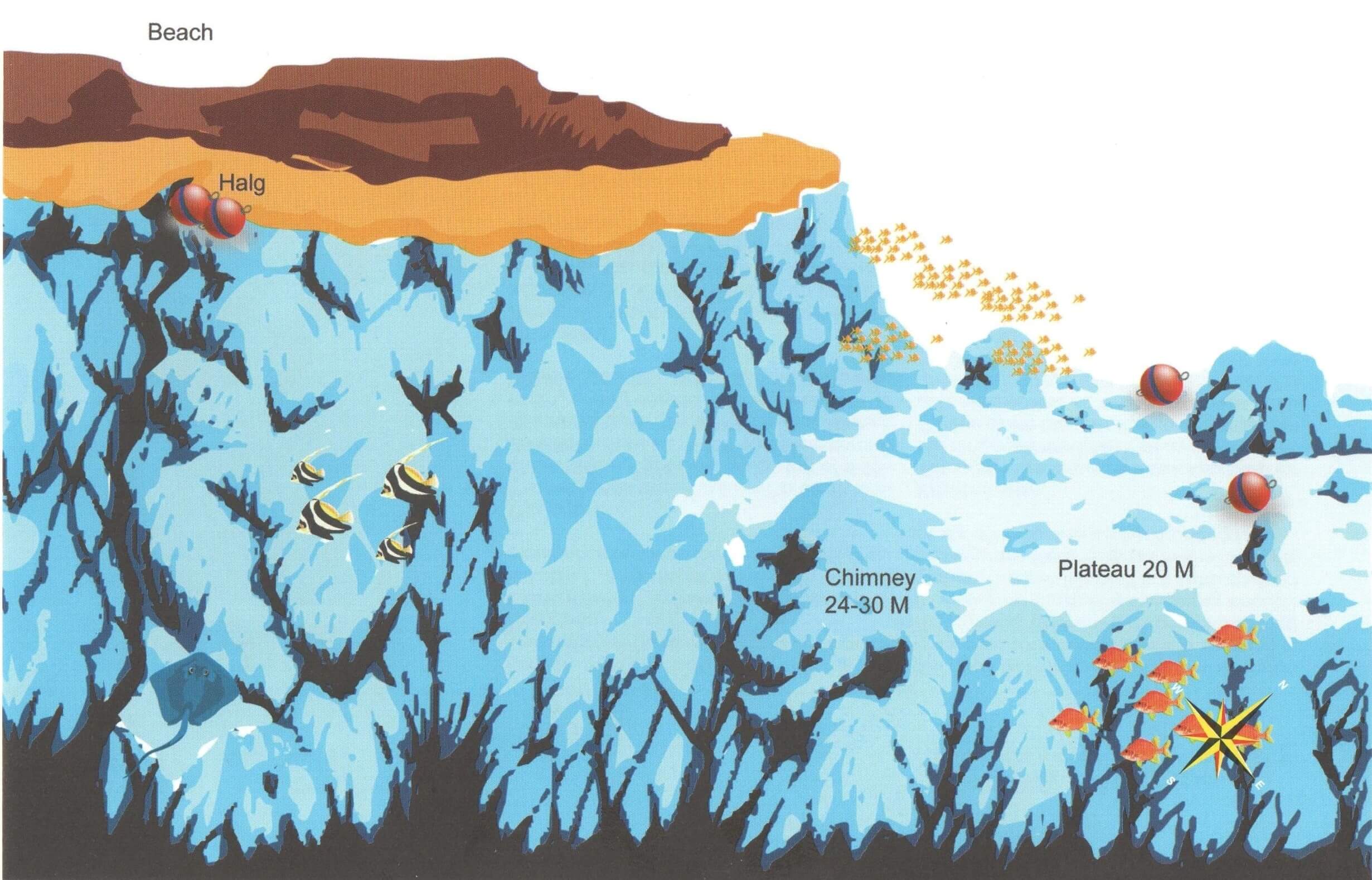
LOCATION: Hurghada
DESCRIPTION: Wall dive
DEPTH: 50 metres
VISIBILITY:20 – 25 metres (65 – 80 feet)
North Abu Ramada is a real adventure to dive and is subject the weather and sea conditions as the area can have strong currents. Descend to a plateau at 22metres from where there are drop off on two sides.
This reef has the nickname “The Aquarium” thanks to its enormous schools of fish. Even reef fish, usually in pairs, tend to cluster in large groups here. Moray eels inhabiting the many caves on its western side make up for the relative scarceness of other marine life. But fish populations increase dramatically along the northern wall. The enormous schools of bannerfish are particularly impressive, along with barracuda, tuna, blue spotted rays and the occasional shark.
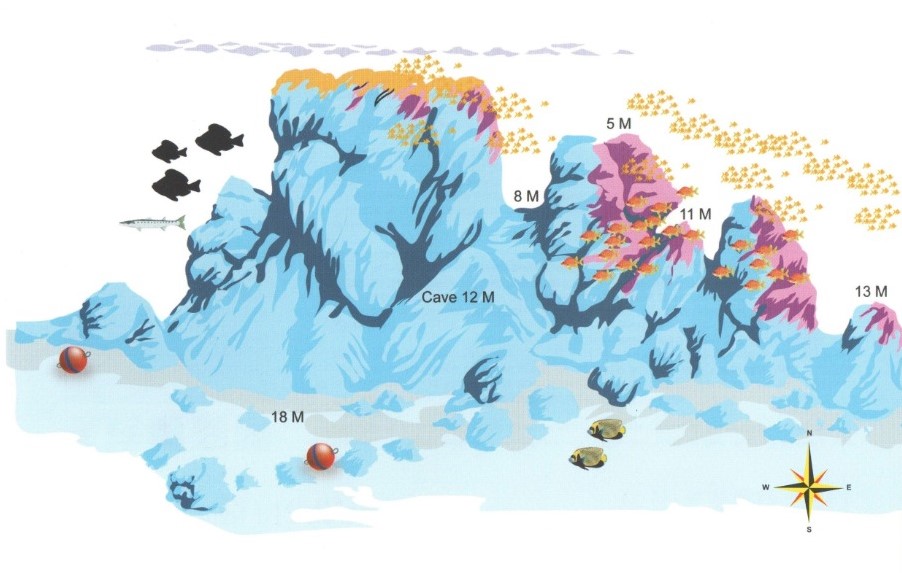
LOCATION: Hurghada
DESCRIPTION: Wall dive
DEPTH: 20 metres
VISIBILITY: 20 – 25 metres (65 – 80 feet)
This small site, on a group of coral pinnacles just offshore from Abu Ramada, is an incredibly dense collection of the best in coral growth and reef fishes. The pinnacles are carpeted in rich layers of coral, with colourful soft corals predominating, along with some gorgonians and a fairly wide range of stony species. The openings and walls of the caves are often particularly vibrant, with colonies of dendronephthia and other vividly coloured soft corals.
This can be a challenging dive for which you need to be at least an Advanced Open Water Diver. Drop down the wall to a small plateau at 22metres before the sea drop away to the abyss. To the east the next you find is Saudi Arabia… so almost any kinds of fish, especially the larger roaming fish can be seen at this site.
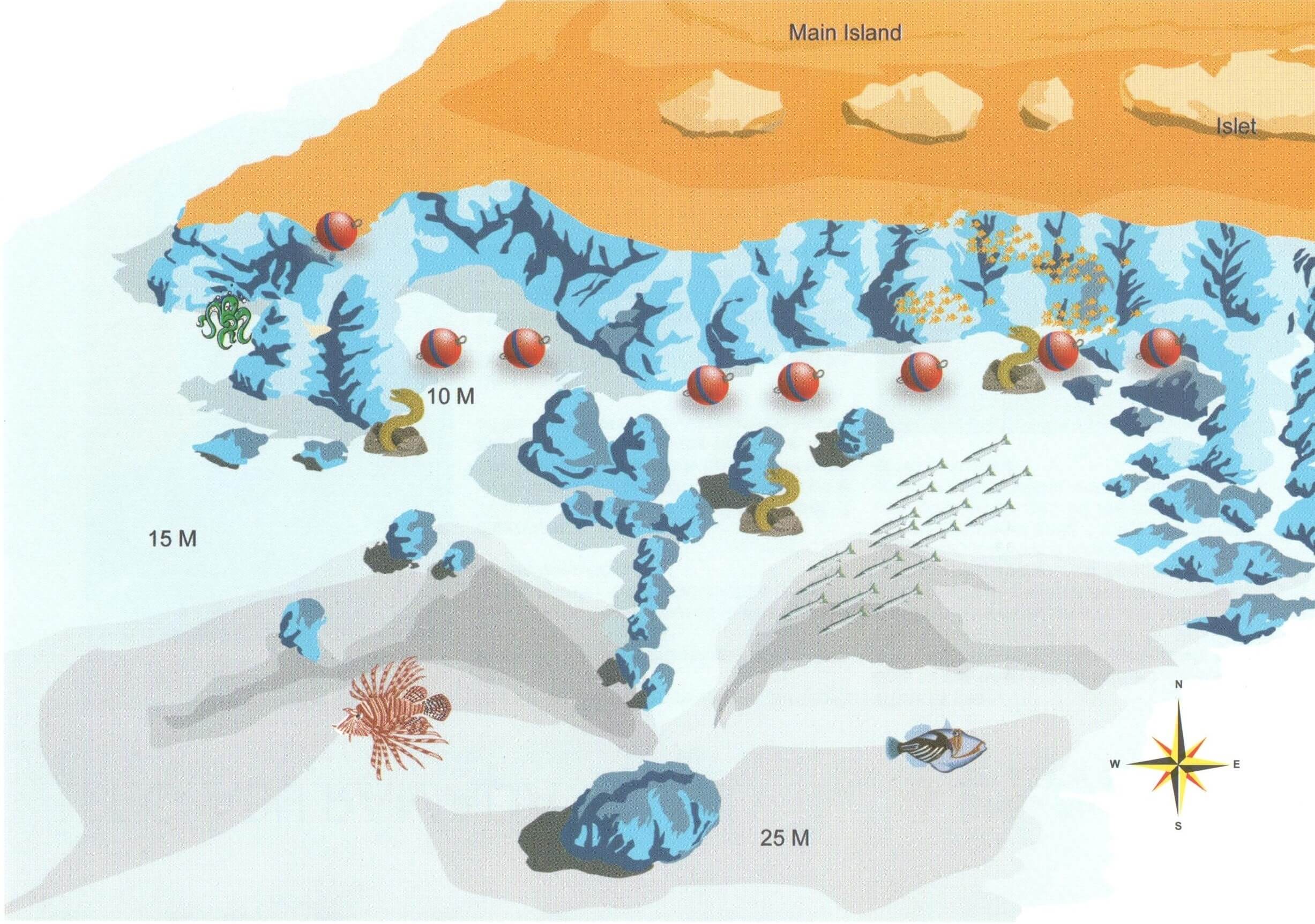
LOCATION: Hurghada
DESCRIPTION: Wall dive and coral garden
DEPTH: 15 metres
VISIBILITY: 10-25 metres
South Abu Ramada (also known as Abu Ramada South) is a dive site with huge reefs of hard and soft corals and sea fans sitting on a sandy bottom, and a very old wreck that is very much decayed. Aside from diving, the South Abu Ramada site is famous for being a good snorkeling spot. Photography lovers can also enjoy good conditions for taking photos.
When to go
There is no distinctive diving or non-diving season in this area, so diving is a year-round activity. For divers who prefer a high water temperature as one of their main criteria, it is better to go in July through September, when the water temperature averages 28C/82F. The coolest water temperature is from December to February (21C/69F).
What to see
Old wreck, soft and hard corals, sea fans, staghorn corals, feather corals, sponges, turtles, moray eels, blue-spotted stingrays, spadefish, lionfish, and clownfish.
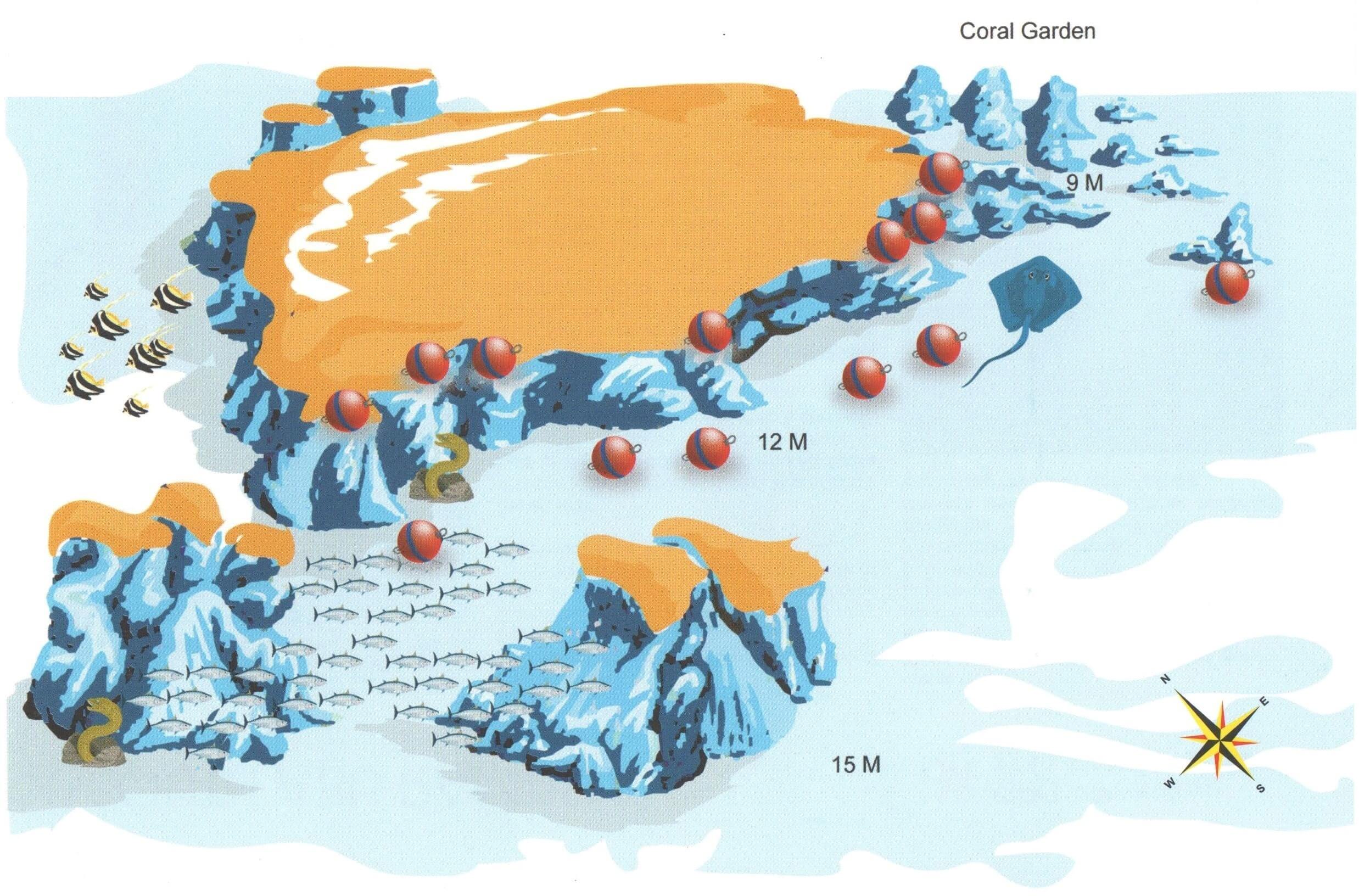
LOCATION: Hurghada
DESCRIPTION: Wall dive
DEPTH: 15 metres
VISIBILITY: 20 – 25 metres (65 – 80 feet)
RATING: ****
An excellent dive site, the shallow reef has plenty of coral outcrops away from the main reef to explore around and there is an abundance of life wherever you look. Because of the shallow depth there is plenty of light making it an excellent dive for taking photos. There are a couple of eagle rays that have made this reef there home and are often come across by divers. Crocodilefish and stonefish are also something to look out for and underneath where the day boats moor there were some nesting triggerfish to steer clear of!
The try dives going on at this site led to plenty of amusement for us with one person being led around by a dive guide holding their pillar valve, doing what could only be described as doggy paddle through the water. Unfortunately we also saw a guide seating a try diver on a coral mound before swimming backwards to take their photo. The poor beginner was struggling to stay on the coral and I’m sure the coral disliked it even more.
This dive is also known as ‘the Aquarium’, as are several dive sites in the Red Sea, and with good reason. Many fish types are here, sweetlips, clownfish etc…I haven’t seen try dives done here but they probably are! The guide was probably after a big tip from the Russian guest!!!
Ian Higgins
Gota Abu Ramada is a medium sized, oval-shaped reef with a shallow, flat, sandy seabed surrounding it. This is one of the most popular sites for your first dive from the day boats in Hurghada. The shallow depths (around 10 metres to the seabed at the base of the reef) make it an ideal spot for dive guides to bring divers they have not dived with before and give a picturesque dive whilst assessing dive capabilities for dive planning purposes later in the week. There is something here for all levels of diver, whilst giving an easy introduction to Red Sea diving. Don’t be put off if you’re an experienced diver (there’s plenty of time for the deep walls
Current is not normally a consideration here, however if it is running it is likely to run from the north towards the south. Off the north east side of the reef is a separate erg, which is covered in orange fire coral and huge shoals of yellow snapper often congregate here. This is likely to be the furthest part of your dive if you are diving out and back from your boat along the east side of the reef, but it’s well worth the swim. The north eastern side and north western side both have lovely coral gardens with dozens of small coral encrusted blocks out on the sand seabed, so don’t just stay on the reef itself. Boats moor on the mooring ropes on the south side of the reef and then the dive plan is normally to dive either the west side or east side of the reef by doing an “out and back dive”. If your boat does happen to have a zodiac or RIB then definitely get dropped on the north side where the coral and fish life is more pristine and then make a “one way dive” back to your boat. This site can get really busy, so it’s a good idea to take a look up at your boat after entry to establish any unique characteristics for identifying it upon return. This one tough little reef – dived relentlessly 7 days a week, 52 weeks a year and often with up to 20 boats tied in, the continued quality of coral and diversity of marine life never ceases to amaze me. If there is a prime example of how the reefs of the Red Sea are standing up to the amount of divers visiting them, then this has got to be it. For all the diving and boat traffic, Gota Abu Ramada continues to thrive as a marine environment.

LOCATION: Hurghada Sahl Hasheesh
DESCRIPTION: Wall, sandy plateau and coral garden
DEPTH: 5 – 27 metres
VISIBILITY: 30 metres
The Oberoi House Reef is distinguished by its ecological diversity and beautiful coral reef.
In the front of the Jetty, the coral reef begins right and left, and in the front is a sandy bottom full of sea trunks that descends at a depth of 10 meters to a huge area of sea grass where the sea horse and many other fish such as box fish, trigger fish. In the eastward direction at a depth of 28 meters there is a coral garden.
To immediately experience what the Red Sea has to offer, you need to go no further than the end of our private jetty. As soon as you enter the calm sheltered sea you are on our own pristine well-kept house reef.
In our beautiful house reef you can do more than 5 dives from north and south site
Featuring a large sandy plateau with depths from 5 m to 30 meters and barely currents, our house reef provides the perfect environment to conduct course, experience and pleasure dives for divers of all levels. It’s the ideal spot for our qualified divers who haven’t dived in a while to ease themselves gently back into the water in preparation for reef dives further afield. Our house reef is also a popular choice for the guests who fancy a dive that doesn’t involve boats or travel times to other sites. With a gentle stroll down the jetty where they find their equipment set up for them, our guests find themselves submerged into another world of coral heads, small walls and caves making this one of the best house reef dives in the area.
On the northern side we dive with the currents which is always quiet, and then head south with the beautiful coral reefs until you reach the jetty, one the way we can see- Sea horse, eagle rays even dolphins if you’re lucky.

LOCATION: Hurghada
DESCRIPTION: Reef dive
DEPTH: 1 – 14 metres (3 – 46 feet)
VISIBILITY: 15 metres (50 feet)
RATING: ***
RasDishet as a weight check dive on the way to Safaga located in SahlHasheesharea . The main reef emerges up from a sandy seabed and there are a few separate coral clusters out from the main reef. The overall biodiversity was excellent and the coral very healthy. We saw plenty of the usual reef fish such as crown butterflyfish, clownfish, lizardfish, goatfish and parrotfish. There were also a lot of very small gobies perched on the sand, each one within a quick swim of its burrow. A massive pufferfish was resting on the ground, gently rocking, seemingly unperturbed by a group of divers swimming over it.
RasDishet is located about an hour south of Hurghada and two hours north of Safaga. The reef extends out from the shoreline and there is an old light beacon on top of the reef at its eastern point. Dive boats usually more on the south eastern side of this outcrop and divers make an “out and back” dive. Using a zodiac or RIB to drop divers around or drop divers by the boat to the north is a great option where you can follow the reef wall (reef wall to right hand shoulder) back to your boat. The coral quality on the northern wall is colorful as this area is slightly less dived. On the southern part of the reef the wall segments into smaller sections which can be a little disorientating and a compass is a useful tool. To the south east is an erg (small reef piece) which is well worth a circuit or two. Large numbers of antheas (gold fish) cover the upper sections. The seabed fluctuates between 10m at the reef and 15m at the erg and is sandy making this an ideal site for novice or beginners. There are batfish and often large pufferfish rest on the seafloor. Look for lionfish in the small overhangs. It’s rare to encounter any current here although if venturing far around to the north in a zodiac or RIB current could be a consideration usually running from the north to south.
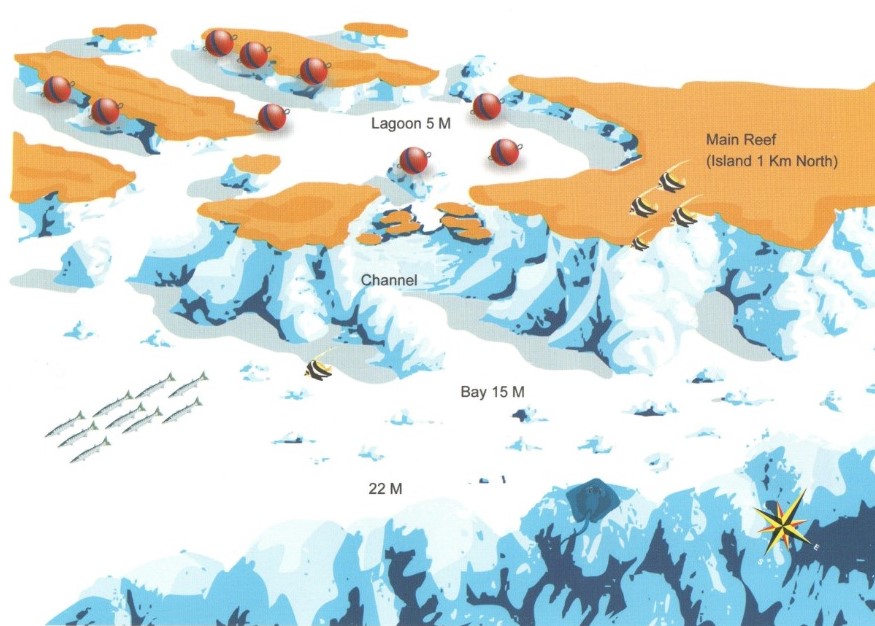
LOCATION: Hurghada
DESCRIPTION: Wall, sandy plateau and seagrass area
DEPTH: Wall drops away to about 50m (165 feet), sandy areas average about 10m (30 feet)
VISIBILITY: 10 metres (30 feet)
RATING: **
Abu Hasheesh means ‘Father of Grass’, named because of the seagrass found at this site. The site is made up of a sloping wall that is topped by a sandy plateau between 10 and 20 metres. On the plateau there is another coral ridge from 10m to the surface. There is also an area of seagrass (over which the boats moor) which gives the site its name.
We moored at this reef overnight in the sandy area and did a night dive in the shallows and a morning dive on the wall. On the way out on the night dive the reef was proving to be rather uninspiring and there was not much of note to see. On the way back I decided to swim over the sand and seagrass area in the hope that I might spot a seahorse. I didn’t see one but what I did see was a tiny baby cuttlefish and a tiny octopus, both about the size of a thumbnail. The octopus went purple when it saw me in effort to try and stop me from eating him but the cuttlefish just pretended it wasn’t there. Also in the sand was a crab and a hermit crab. These four little critters made an otherwise dull dive worthwhile! The wall dive was not up to much either, there were all the usual reef suspects, but nothing noteworthy.
I was told the site was named after smugglers who used to dump their hashish here to avoid detection. Apparently there is a cave somewhere around here under the surface where they used to hide it. Nice story if probably not true!
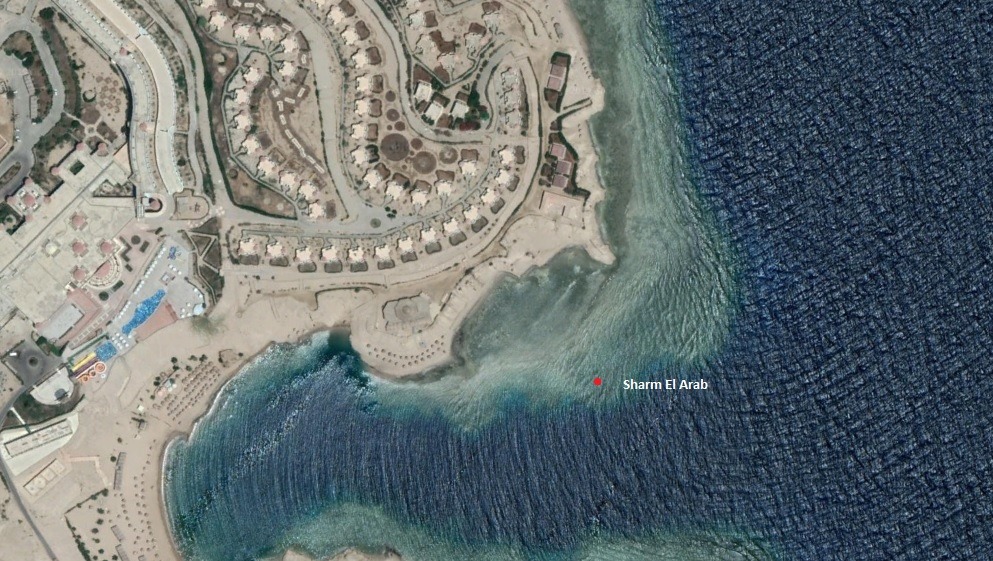
LOCATION: Hurghada Makadi Bay
DESCRIPTION: Wall dive
DEPTH: 30m
VISIBILITY: 20 – 25 metres (65 – 80 feet)
Sharm El Arab is 15 minutes southern located from Makadi Bay. The boat will be fixed inside the big lagoon. Under the boat will be a beautiful wall (20 – 40m)overgrowned with colourful corals. The dive will go along this wall, right shoulder till you reach the plateau (18 – 28m) with nice big table corals.Turtles, Barrakudas,Snails,ShortnoseDoctorfish to be found here. With some luck also Dolphines.
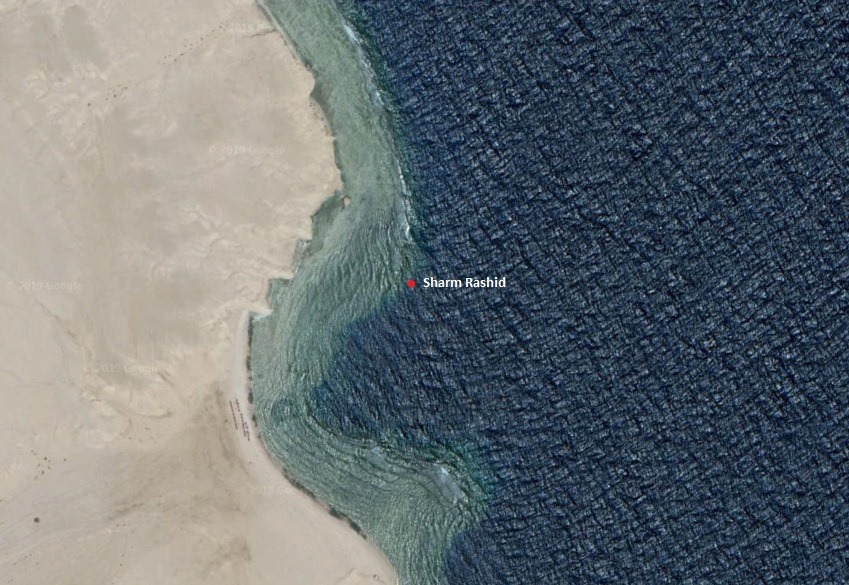
LOCATION: Hurghada Makadi Bay
DESCRIPTION: Wall dive
DEPTH: 30m
VISIBILITY: 20 – 25 metres (65 – 80 feet)
Sharm Rashid is a small aisle in the cost southern MakadiBay.Here you can dive to the south direction, but also to the east. Both sides proffers a lot of corals and fishes. The depth between 7m and 30m.
 El Mina (the Harbour Wreck)
El Mina (the Harbour Wreck)